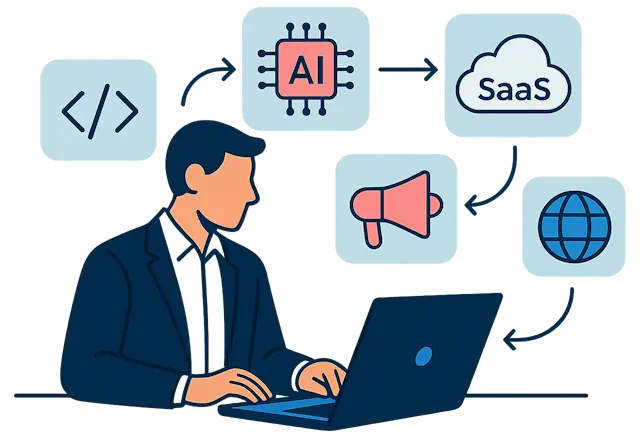Backend Scaling Strategies for Global Applications in 2025
Last Updated: February 22nd 2025

Too Long; Didn't Read:
In 2025, backend scaling is critical for global applications, with nearly 5 billion internet users demanding flawless performance. Key strategies include microservices architecture, cloud-based solutions, and scalable design principles, relying on providers like AWS and Google Cloud for adaptive resource management. Teams using modular design deploy updates 30% faster, while stateless designs boost scalability by 70%. API-first design accelerates development by 50%, and AI-driven real-time monitoring tools cut operational costs by 20-25%. These techniques ensure robust performance and reliability, essential for handling heavy global traffic efficiently.
Backend scaling has become super important in 2025, with the internet reaching nearly 5 billion users worldwide who expect nothing less than perfect performance.
Real-time applications have totally changed how businesses connect with users, making traditional scaling methods feel ancient.
Cloud infrastructure spending is projected to hit $150 billion this year, as companies realize they need serious backend power to handle global traffic. Smart scaling strategies now focus on microservices, which break down applications into smaller, manageable pieces that can grow independently.
This approach makes everything run smoother and helps avoid those embarrassing system crashes. Backend developers are getting creative with solutions, implementing everything from API-first design to advanced caching techniques.
The game-changers include cloud services from AWS and Google Cloud, which automatically adjust resources based on demand, plus essential tools like GraphQL for data management, and monitoring platforms such as New Relic for keeping everything running at peak performance.
These aren't just fancy tech terms - they're the building blocks that keep your favorite apps working perfectly, no matter how many people are using them.
Table of Contents
- Scalable Design Principles
- Understanding Microservices Architecture
- Leveraging Cloud-Based Solutions
- Implementing API-First Design
- Ensuring Data Scalability
- Load Balancing and Traffic Management
- Real-Time Performance Monitoring
- Emerging Trends in Backend Strategies
- Case Studies: Success Stories in Backend Scaling
- Frequently Asked Questions
Explore the future with emerging microservices and serverless architecture trends influencing backend development.
Scalable Design Principles
(Up)Building scalable backend systems in 2025 requires a smart approach to design principles that can handle massive user growth. Modern scalable applications rely on three key elements: loose coupling, modular design, and statelessness.
These aren't just buzzwords - they're essential for creating systems that can grow without breaking. Think of loose coupling like building with LEGO blocks - each piece works independently but fits perfectly with others.
This makes it super easy to swap out components or scale specific parts without messing up the whole system.
- Loose coupling is like building with LEGO blocks - each piece works independently but fits perfectly with others. This makes it super easy to swap out components or scale specific parts without messing up the whole system.
Modular design takes things further by breaking down applications into smaller, manageable pieces.
Current system design practices show that this approach lets teams work on different parts simultaneously and deploy updates faster.
It's like having multiple mini-applications instead of one giant one. The data backs this up - teams using modular design are deploying updates 30% faster and seeing fewer system failures.
- Modular design enables teams to work on different parts simultaneously and deploy updates faster. Teams using this approach are deploying updates 30% faster and seeing fewer system failures.
When it comes to handling tons of users, statelessness is absolutely crucial.
Horizontal scaling strategies work best when each request contains everything needed to process it, without relying on previous interactions.
This means servers can handle more requests independently, making it easier to add more servers when needed. Recent tests show that stateless designs can improve scalability by up to 70%, which is huge for applications aiming for global reach.
- Statelessness allows each request to contain all necessary information, enabling servers to handle more requests independently and easily add more servers.
Understanding Microservices Architecture
(Up)Microservices architecture has become a game-changer for scaling global applications, breaking down massive applications into smaller, independent pieces that work together seamlessly.
According to AWS research, this approach makes applications easier to scale and accelerates development cycles, letting teams ship new features faster than ever.
Each service handles its own specific task and can be scaled up or down based on demand, which is super practical for managing resources efficiently. By 2025, most major tech companies have jumped on board with microservices because they just make sense for handling heavy workloads.
What's really cool about microservices is how they handle growth and scaling.
VMware's analysis shows that independent scalability is one of the most powerful advantages - you can boost resources for busy services without touching the ones that are cruising along fine.
Think about it like having different volume controls for each speaker at a concert instead of one master control. Each service can be updated, modified, or scaled without messing with the others, which is honestly pretty amazing for keeping everything running smoothly.
The real-world impact is impressive - major companies using microservices have seen massive improvements in their ability to handle user traffic and roll out new features.
This architecture style isn't just about handling more users; it's about being smart with resources and making sure applications can grow without breaking the bank.
Teams can work independently on different services, ship updates faster, and fix issues without causing system-wide problems. This means better reliability, quicker updates, and way fewer headaches when something goes wrong.
For global applications in 2025, microservices aren't just an option - they're pretty much essential for staying competitive and delivering the kind of performance users expect.
Leveraging Cloud-Based Solutions
(Up)The cloud computing landscape in 2025 has become a game-changer for scaling backend systems globally. Serverless computing stands out as a major trend, with providers like AWS Lambda, Google Cloud Functions, and Azure Functions making it easier than ever to build scalable applications without managing infrastructure.
These solutions are perfect for handling unpredictable workloads and can seriously cut down on costs since you only pay for what you actually use. The big three cloud providers - AWS, Azure, and Google Cloud Platform - are constantly pushing the envelope with new features and services that make backend scaling almost automatic.
What's really cool is how each cloud platform brings something unique to the table.
AWS leads with the most comprehensive service portfolio and global reach, Azure kills it with Microsoft integration and enterprise features, and Google Cloud Platform stands out with its amazing AI and machine learning capabilities.
They're all competing to provide the best tools for developers, which means we get better services and more competitive pricing. The market is growing fast, and it's projected to hit over $2 trillion by 2030.
A super important aspect that's often overlooked is how modern backend development has shifted towards cloud-native approaches.
Managed services like Amazon RDS, Google Cloud SQL, and Azure Database handle all the boring stuff - backups, updates, and scaling - automatically. This means developers can focus on writing actual code instead of dealing with infrastructure headaches.
Plus, with features like auto-scaling and load balancing built right in, applications can handle traffic spikes without breaking a sweat. These platforms are making it possible for even smaller teams to build and maintain applications that can compete on a global scale.
Implementing API-First Design
(Up)API-first design has become a game-changer in backend development for global applications in 2025. This approach puts API design at the core of development, enabling teams to work simultaneously on different components while maintaining consistent integration points.
The strategy has proven incredibly effective, with studies showing significant improvements in both development speed and application reliability. When implemented correctly, API-first design reduces development costs and accelerates time-to-market, making it a must-have for modern applications.
Teams adopting this approach have reported up to 50% faster development cycles and substantial reductions in integration issues.
One of the coolest aspects is how API-first principles promote better developer experience through clear documentation and intuitive interfaces.
By focusing on API design before implementation, teams can create more user-friendly and maintainable systems. This approach has been especially crucial for microservices architectures, where solid API design serves as the foundation for scalable, distributed systems.
The emphasis on early planning and documentation has shown to reduce debugging time by up to 75% and improve overall code quality.
The real power of API-first design comes from its ability to enhance integration and foster innovation across different platforms and services.
Companies implementing this strategy have seen improved collaboration between frontend and backend teams, faster feature deployments, and better adaptability to changing requirements.
In 2025, this approach isn't just about writing better code - it's about creating scalable, future-proof applications that can evolve with business needs while maintaining robust performance and reliability.
Ensuring Data Scalability
(Up)In 2025, data scalability has become absolutely crucial for applications serving users worldwide. The game-changing database sharding technique splits massive databases into smaller, manageable pieces that work together smoothly.
This strategy has transformed how companies like Netflix and DoorDash handle their massive user bases, with performance improvements hitting up to 45% faster query times.
What's really cool is how companies are mixing different approaches - some use geographic sharding for regional data, while others go with hash-based distribution for more even performance.
The latest trend everyone's talking about is building future-ready data platforms that can grow without breaking a sweat.
The key is using smart combinations of sharding, replication, and distributed systems. These aren't just buzzwords - they're essential tools that let applications scale up or down instantly based on user demand.
The results speak for themselves, with companies reporting 40% fewer data problems when they implement these strategies correctly.
Speaking of performance boosts, modern caching solutions are changing the game completely.
Using tools like Redis and Memcached, applications can serve data super fast while reducing database strain by up to 70%. It's pretty amazing how these tools work together - imagine having a speed dial for your most-used data while keeping everything else organized and accessible.
The best part? These aren't just theoretical improvements - real companies are using these techniques right now to handle millions of users without breaking a sweat.
Load Balancing and Traffic Management
(Up)The load balancer market is transforming rapidly, with projections showing growth from $7.09 billion in 2025 to $19.40 billion by 2033.
This massive expansion is driven by the surge in cloud-based applications and microservices architecture. Tools like NGINX and HAProxy continue leading the charge, with new strategies for microservices load balancing are changing the game, especially with adaptive weights and latency-aware routing.
The latest player shaking things up is Cloudflare, which just dropped some seriously advanced features that totally eliminate the need for hardware-based solutions, making it easier for developers to manage traffic distribution.
What's particularly exciting is how these tools now handle both public and private traffic flows seamlessly, with enhanced security features built right in. For smaller applications and startups, this means getting enterprise-level performance without breaking the bank on expensive hardware.
The integration of AI-driven analytics helps spot potential issues before they become problems, while automated scaling adjusts to traffic spikes in real-time.
These advancements are making it possible for applications to maintain lightning-fast response times even when dealing with millions of users globally.
Real-Time Performance Monitoring
(Up)Real-time performance monitoring has become absolutely crucial for managing global applications in 2025. Recent analysis shows Datadog leading in infrastructure and cloud monitoring, while New Relic excels in application performance management.
These platforms are total game-changers - according to McKinsey, organizations using real-time monitoring can slash operational costs by 20-25%. The tools have evolved beyond simple tracking: they now offer predictive analytics, automated incident response, and seamless cloud integration.
Real-time monitoring systems work through a continuous cycle of collecting data, spotting patterns, and generating instant alerts, making it easier than ever to catch and fix issues before users even notice.
What's really cool about modern monitoring is how it tackles performance bottlenecks.
Using AI-powered anomaly detection, these systems can predict potential issues hours or even days before they become problems. The latest APM metrics show that key factors like Apdex scores, response times, and error rates are vital for maintaining optimal performance.
For example, a one-second delay in response time can lead to a 7% drop in conversions - that's serious money we're talking about. The most successful companies are the ones using these tools to stay ahead of issues, not just react to them.
Looking at real success stories, major tech companies have transformed their operations with these monitoring solutions.
Netflix's implementation of advanced monitoring tools has led to a 75% customer retention rate through better service reliability. Amazon processes over 2.5 billion database requests daily with minimal issues, thanks to comprehensive monitoring systems.
The data doesn't lie - organizations using real-time monitoring are seeing up to 50% faster mean time to recovery during incidents. It's clear that in 2025, if you're not monitoring in real-time, you're basically playing catch-up.
Emerging Trends in Backend Strategies
(Up)The backend development scene in 2025 is totally transforming how we build and scale applications globally. AI-powered development tools are leading the charge, making it easier for developers like me to create and manage complex systems.
Traditional tech stacks are evolving, with APIs and automation tools handling tasks that used to take hours of coding. Platform engineering is becoming super important, helping teams work faster and smarter through self-service APIs and automated processes.
I've noticed that cross-functional engineering teams are becoming the new normal, breaking down the old-school barriers between different development departments.
What's really exciting is how data technologies are staying stable while everything else evolves - SQL is still king, but now we're seeing it work alongside AI in ways that make our jobs so much more efficient.
Companies that jump on these trends early are seeing massive improvements in their deployment times and overall performance. Working with these tools feels like being part of a revolution in how we build software - it's literally changing every day, and I'm here for it!
Case Studies: Success Stories in Backend Scaling
(Up)Netflix's journey to backend scaling success is seriously impressive! As someone diving into tech, it's mind-blowing to see how they handle over 260 million users globally in 2024.
Their transformation from a DVD rental service to a streaming giant showcases the power of smart architecture choices. Their three-part system design - the client side, backend services, and their custom Content Delivery Network called Open Connect.
They're not afraid to break things to make them better! Their Chaos Monkey testing tool randomly shuts down production instances to make sure everything stays reliable.
Their backend game is super strong with microservices running on AWS, and they've got this amazing custom CDN that handles about 15% of global internet traffic.
They process like 500 billion events daily using Kafka, which is just crazy to think about. What makes this even cooler is how they handle all this data - they've got these smart caching systems and use tools like Cassandra for their massive databases.
Everything they do is focused on making sure users can binge-watch their favorite shows without any buffering issues. And let's be real, we've all been there during a late-night streaming session!
Frequently Asked Questions
(Up)Why is backend scaling important for global applications in 2025?
Backend scaling is crucial in 2025 due to the internet's reach of nearly 5 billion users worldwide. This requires perfect performance and advanced scaling strategies to handle massive global traffic, as traditional methods are insufficient.
What are the key elements of scalable design principles?
The key elements are loose coupling, modular design, and statelessness. These principles allow for independent component scalability, faster deployment of updates, and improved system reliability.
How do microservices architecture benefit scaling global applications?
Microservices architecture allows for independent scalability of services, enabling resources to be adjusted for high-demand areas without affecting others. This results in faster feature deployment and can handle heavy workloads efficiently.
What role do cloud-based solutions play in backend scaling?
Cloud-based solutions facilitate scalable applications by offering serverless functions and managed services that handle infrastructure tasks like backups and updates. Leading providers like AWS, Google Cloud, and Azure enable automatic resource adjustment and cost-effective scaling.
How does API-first design enhance backend development?
API-first design enhances backend development by allowing simultaneous work on various components, reducing development costs, and speeding up time-to-market. It ensures consistent integration, leading to more reliable and maintainable systems, which is essential in microservices architecture.
Step into the future of tech by embracing a functionless mindset and leveraging global managed services.
Discover how MySQL's strengths in speed and usability cater to modern web applications.
Learn about the Best Practices for Automated Documentation to maintain streamlined project workflows.
Experience the advantages of daemonless designs that modern container runtimes offer.
Understanding observability's relevance to 2025 is crucial as we approach a new era of cloud-native backend development.
Delve into the intricacies of Real-time data processing in Python and its impact on modern applications.
Explore how Python's dominance in AI and machine learning is revolutionizing CI/CD practices in modern backend systems.
Discover the key modernization challenges that companies face when dealing with outdated codebases.
Ludo Fourrage
Founder and CEO
Ludovic (Ludo) Fourrage is an education industry veteran, named in 2017 as a Learning Technology Leader by Training Magazine. Before founding Nucamp, Ludo spent 18 years at Microsoft where he led innovation in the learning space. As the Senior Director of Digital Learning at this same company, Ludo led the development of the first of its kind 'YouTube for the Enterprise'. More recently, he delivered one of the most successful Corporate MOOC programs in partnership with top business schools and consulting organizations, i.e. INSEAD, Wharton, London Business School, and Accenture, to name a few. With the belief that the right education for everyone is an achievable goal, Ludo leads the nucamp team in the quest to make quality education accessible


